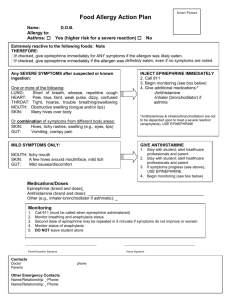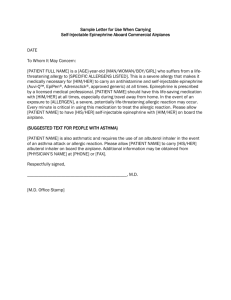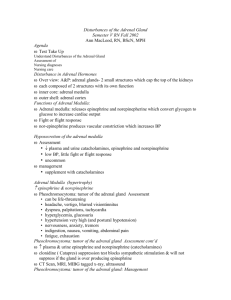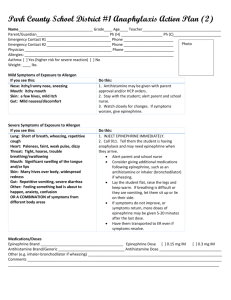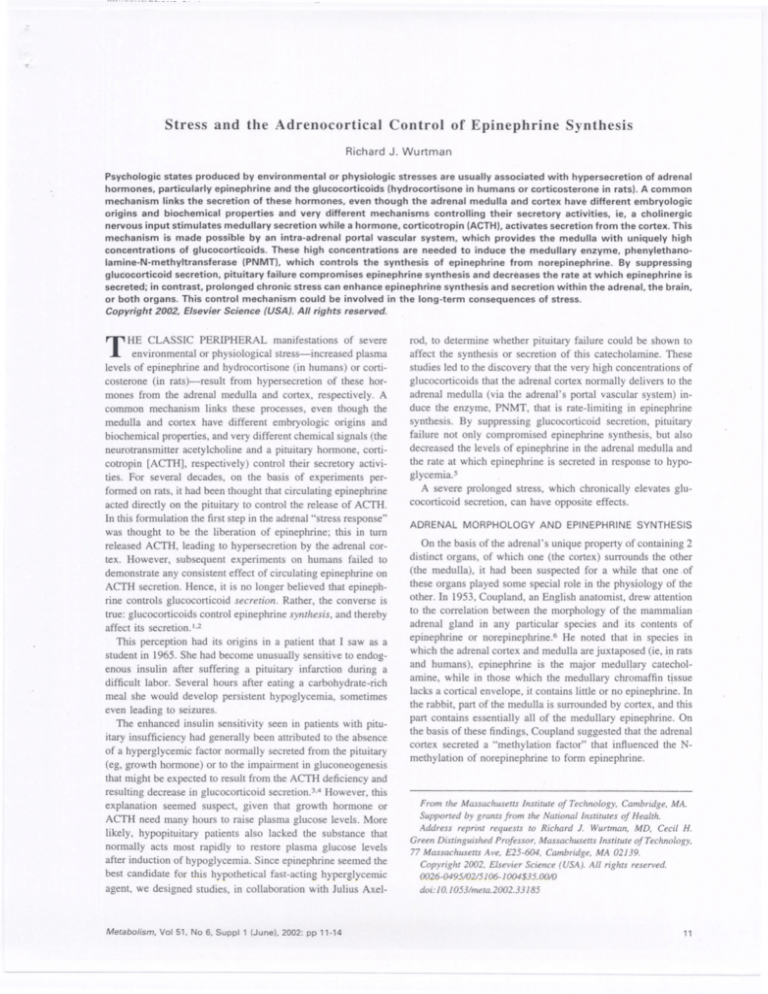
Stress and the Adrenocortical
Control
of Epinephrine
Synthesis
Richard J. Wurtman
Psychologic states produced by environmental or physiologic stresses are usually associated with hypersecretion of adrenal
hormones. particularly epinephrine and the glucocorticoids (hydrocortisone
in humans or corticosterone in rats). A common
mechanism links the secretion of these hormones. even though the adrenal medulla and cortex have different embryologic
origins and biochemical properties and very different mechanisms controlling their secretory activities. ie. a cholinergic
nervous input stimulates medullary secretion while a hormone. corticotropin (ACTHI. activates secretion from the cortex. This
mechanism is made possible by an intra-adrenal portal vascular system. which provides the medulla with uniquely high
concentrations
of glucocorticoids. These high concentrations
are needed to induce the medullary enzyme. phenylethanolamine-N-methyltransferase
(PNMT). which controls the synthesis of epinephrine from norepinephrine.
By suppressing
glucocorticoid secretion. pituitary failure compromises epinephrine synthesis and decreases the rate at which epinephrine is
secreted; in contrast. prolonged chronic stress can enhance epinephrine synthesis and secretion within the adrenal. the brain.
or both organs. This control mechanism could be involved in the long-term consequences
of stress.
Copyright 2002. Elsevier Science (USA). All rights reserved.
HE CLASSIC PERIPHERAL manifestations of severe
environmental or physiological stress-increased plasma
levels of epinephrine and hydrocortisone (in humans) or corticosterone (in rats)-result from hypersecretion of these hormones from the adrenal medulla and cortex, respectively. A
common mechanism links these processes, even though the
medulla and cortex have different embryologic origins and
biochemical properties, and very different chemical signals (the
neurotransmitter acetylcholine and a pituitary hormone, corticotropin [ACTH), respectively) control their secretory activities. For several decades, on the basis of experiments performed on rats, it had been thought that circulating epinephrine
acted directly on the pituitary to control the release of ACTH.
In this formulation the first step in the adrenal "stress response"
was thought to be the liberation of epinephrine; this in turn
released ACTH, leading to hypersecretion by the <ldrenalcortex. However, subsequent experiments on humans failed to
demonstrate any consistent effect of circulating epinephrine on
ACTH secretion. Hence, it is no longer believed that epinephrine controls glucocorticoid secretion. Rather, the converse is
true: glucocorticoids control epinephrine synthesis, and thereby
affect its secretion.1.2
This perception had its origins in a patient that I saw as a
student in 1965. She had become unusually sensitive to endogenous insulin after suffering a pituitary infarction during a
difficult labor. Several hours after eating a carbohydrate-rich
meal she would develop persistent hypoglycemia, sometimes
even leading to seizures.
The enhanced insulin sensitivity seen in patients with pituitary insufficiency had generally been attributed to the absence
of a hyperglycemic factor normally secreted from the pituitary
(eg, growth hormone) or to the impairment in gluconeogenesis
that might be expected to result from the ACTH deficiency and
resulting decrease in glucocorticoid secretion.3.4However, this
explanation seemed suspect, given that growth hormone or
ACTH need many hours to raise plasma glucose levels. More
likely, hypopituitary patients also lacked the substance that
normally acts most rapidly to restore plasma glucose levels
after induction of hypoglycemia. Since epinephrine seemed the
best candidate for this hypothetical fast-acting hyperglycemic
agent, we designed studies, in collaboration with Julius Axel-
T
Metabolism.
--
Vol 51, No 6, Suppl 1 (June), 2002: pp 11-14
rod, to determine whether pituitary failure could be shown to
affect the synthesis or secretion of this catecholamine. These
studies led to the discovery that the very high concentrations of
glucocorticoids that the adrenal cortex normally delivers to the
adrenal medulla (via the adrenal's portal vascular system) induce the enzyme, PNMT, that is rate-limiting in epinephrine
synthesis. By suppressing glucocorticoid secretion, pituitary
failure not only compromised epinephrine synthesis, but also
decreased the levels of epinephrine in the adrenal medulla and
the rate at which epinephrine is secreted in response to hypoglycemia.5
A severe prolonged stress, which chronically elevates glucocorticoid secretion, can have opposite effects.
ADRENAL MORPHOLOGY AND EPINEPHRINE SYNTHESIS
On the basis of the adrenal's unique property of containing 2
distinct organs, of which one (the cortex) surrounds the other
(the medulla), it had been suspected for a while that one .of
these organs played some special role in the physiology of the
other. In 1953, Coupland, an English anatomist, drew attention
to the correlation between the morphology of the mammalian
adrenal gland in any particular species and its contents of
epinephrine or norepinephrine.6 He noted that in species in
which the adrenal cortex and medulla are juxtaposed (ie, in rats
and humans), epinephrine is the major medul!ary catecholamine, while in those which the medullary chromaffin tissue
lacks a cortical envelope, it contains little or no epinephrine. In
the rabbit, part of the medulla is surrounded by cortex, and this
part contains essentially all of the medullary epinephrine. On
the basis of these findings, Coupland suggested that the adrenal
cortex secreted a "methylation factor" that influenced the Nmethylation of norepinephrine to form epinephrine.
From the Massachusetts Institute of Technology, Cambridge, MA.
Supported by grants from the National Institutes of Health.
Address reprint requests to Richard J. Wurtman, MD, Cecil H.
Green Distinguished Professor, Massachusetts Institute of Technology,
77 Massachusetts Ave, E25-604, Cambridge, MA 02139.
Copyright 2002, Elsevier Science (USA). All rights reserved.
0026-0495/02/5106-1004$35.00/0
doi: I 0.1 053/meta.2002.33185
11
.
12
RICHARD
Table 1. Effect of Hypophysectomy,
ACTH, and Dexamethasone
on PNMT
T reatment*
Control
Hypophysectomy
Hypophysectomy
PNMT (,..mol/pair)
68.9 :!: 3.4t
6.16 :!: 0.66t
26.5 :!: 2.1
1.46:!: 0.11
46.7 :!: 1.5t
4.76 :!: 0.26t
26.0 :!: 2.3
7.80 :!: O.44t
plus
ACTH
Hypophysectomy
dexamethasone
Adrenal Weight (mg/pairl
plus
*Animals were sham-operated or hypophysectomized
and killed 17
to 21 days later. Some of the hypophysectomized
rats were given
ACTH or dexamethasone
for 6 days prior to autopsy.
tp < .001 v hypophysectomy.
In 1959, Kirshner identified the adrenomedullary enzyme,
PNMT, responsible for the synthesis of epinephrine from norepinephrine.7 Subsequently, Axelrod demonstrated that most of
the epinephrine-forming ability found in adult mammals was
localized within the adrenal glandS; hence, most of the epinephrine released into the circulation had very likely been produced
by PNMT within the adrenal medulla. An isotopic assay was
subsequently developed for PNMT, which simplified measuring the effects of various physiologic states and drugs on
epinephrine biosynthesis.
PITUITARYACTH AND EPINEPRINE
SYNTHESIS
Based on the pathologically prolonged hypoglycemia of our
hypopituitary patient, we initiated studies to see whether the
glucocorticoid hormones were the unknown "methylation factor." Hypophysectomy was found to be associated with a
marked reduction in epinephrine-forming ability (Table I)}
This reduction was of even greater magnitude than the fall in
adrenal weight (which was due largely to a reduction in the
mass of the adrenal cortex). When hypophysectomized rats
were treated with ACTH, PNMT activity was largely restored
with 6 days (Table 1). No other pituitary hormone restored
adrenal PNMT levels after hypophysectomy.
Most of the fall in adrenal PNMT activity occurred within I
week of hypophysectomy; by this time, epinephrine-forming
ability was reduced in the majority of rats to 15% to 20% of
normal. Subsequently, PNMT activity decreased much more
slowly, reaching 10% of control levels 10 weeks after hypophysectomy. The content of epinephrine in the adrenals declined
significantly within 1 week of hypophysectomy; it continued to
fall for as long as animals could be maintained, reaching levels
of about 25% to 35% of normal after 10 weeks."This slow fall
in adrenal epinephrine levels was thought to be consistent with
the epinephrine's known low rate of turnover in adrenals (ie, 7
to 14"days). Adrenal norepinephrine rose somewhat following
hypophysectomy, as might be anticipated. The adrenals of
chronically hypophysectomizeddogs were subsequently shown
not only to contain subnormal epinephrine levels and PNMT
activities, but also to secrete subnormal quantities of epinephrine basally or when made hypoglycemic by injecting insulin.9
Normal epinephrine secretion was restored in this species by
physiologic doses of ACTH. but not by physiologic doses of
glucocorticoids (which, as discussed below, perfuse the me-
J. WURTMAN
dulla in much lower concentrations than those available after
ACTH administration).
GLUCOCORTICOIDS
AND EPINEPHRINE
SYNTHESIS
There were at least 3 possible mechanisms by which ACTH
treatment could have restored PNMT activity in the hypophysectomized rat:
I. The adrenal cortex might have contained an unrecognized epinephrine-forming enzyme, in which case the
decline in cortical mass after hypophysectomy, and its
restoration with ACTH treatment, would be expected to
cause parallel changes in PNMT activity.
2. ACTH could have acted directly on the adrenal medulla
to enhance PNMT activity.
3. ACTH could have stimulated the secretion of glucocorticoids by the adrenal cortex; these compounds, delivered to the medulla by the intra-adrenal portal vascular
system, could then have increased PNMT activity.
To examine the first possibility, we separated the cortex and
medulla from adrenals of hypophysectomized and normal animals, and assayed them individually for PNMT. We found that
the cortex normally contains less than 10% of the epinephrineforming activity of the medulla. (Since no capsule separates the
rat cortex from the medulla, it is possible that even this 10%
represented contamination of-the cortic~1sample with medullary tissue.)
To rule out the possibility that ACTH acted directly on the
adrenal medulla, it was necessary to show that when the level
of glucocorticoids available to the medulla was held constant,
changes in the rate of ACTH secretion had no effect on PNMT
activity}O This was done in 2 ways. First, normal rats were
treated with large doses of dexamethasone, a highly potent
synthetic glucocorticoid. This dose depressed pituitary secretion of ACTH (as demonstrated by a fall in adrenal weight,
Table 2), but provided the tissues with more than adequate
amounts of glucocorticoid. PNMT activity did not fall. Next,
other rats were treated in a like manner with small doses of
metyrapone, a compound that interferes with the synthesis of
adrenal glucocorticoids by inhibiting 11-f3oxidation. Animals
so treated developed adrenal hypertrophy (Table 2), indicating
that ACTH secretion from the pituitary had indeed been elevated. However, epinephrine-forming ability did not show a
parallel rise.
On the basis of the above studies, it could be anticipated that
glucocorticoids would share with ACTH the ability to elevate
PNMT activity in the hypophysectomized animal, if provided
Table 2. Effects of Dexamethasone
and Metyrapone
Activity in Intact Rats
Treatment.
Control
Dexamethasone
Metyrapone
Adrenal Weight
(mg/pair)
54:!: 1.2
35:!: 1.3t
60 :!: 2.2t
PNMT (,.mollpair)
5.12 :!: 0.47
6.02 :!: 0.44
5.12:!:
*Rats were given 1 mg of the drug intraperitoneally
killed on the 7th day.
t P < .001 v control.
on PNMT
0.47
for 6 days and
13
STRESS AND EPINEPHRINE SYNTHESIS
in adequate doses. And when hypophysectomized rats were
given the highly potent drug dexamethasone, it, like ACTH,
fully restored epinephrine-forming activity (Table 1).
These data were thought to indicate that: (1) adrenal PNMT
activity is largely confined to the medulla; and (2) epinephrine
synthesis is controlled by the availability of ACTH, but indirectly, via a route that involves the secretion of glucocorticoids
from the adrenal cortex. Natural and synthetic steroids that
lacked potency as glucocorticoids were found to have no effect
on PNMT.IO
Glucocorticoids added to adrenal homogenates from hypophysectomized rats did not stimulate PNMT activity, and
large doses actually inhibited this activity. This suggested that
these hormones were affecting PNMT activity by controlling
the rate of formation (or destruction) of the enzyme protein. To
test this hypothesis, the ability of dexamethasone to restore
PNMT activity in hypophysectomized rats was measured in
animals pretreated with actinomycin D or puromycin. Neither
agent had a direct effect on PNMT activity, but both blocked
the anticipated rise in epinephrine-forming ability induced by
dexamethasone. This suggested that glucocorticoids secreted
from the adrenal cortex act physiologically to induce the synthesis of new PNMT protein within the adrenal medulla, a
hypothesis subsequently confirmed by the finding that the hor-
monesalso increasePNMTmRNAlevels.I 1.12
EFFECT OF "REPLACEMENT" DOSES OF
GLUCOCORTICOIDS ON EPINEPHRINE-FORMING ABILITY
Although PNMT activity was fully restored by low doses of
ACTH (ie, the doses needed to maintain adrenal weight), the
amounts of glucocorticoid needed to maintain epinephrine synthesis seemed unusually high. The usual "replacement" dose of
glucocorticoid in the rat is thought to be about 0.1 to 0.3 mg (of
corticosterone) per day. Doses higher by tenfold had essentially
no effect on PNMT. It was necessary to treat rats with 100 to
300 times the replacement dose (or its equivalent in dexamethasone) 10 produce a significant restoration of PNMT.'O
Since the effect of ACTH on PNMT had been shown to be
indirect, this great difference between ACTH and glucocorticoid doses suggested that PNMT activity depends not on the
levels of glucocorticoid in the general circulation, but on levels
within the adrenal gland itself. Ordinarily, adrenal venous
blood (which bathes the adrenal medulla after it has perfused
the cortex)6contains about 100 times as much glucocorticoid as
peripheral venous blood. When rats are hypophysectomized,
both intra-adrenal and peripheral glucocorticoid levels decline.
Treatment of hypophysectomized rats with "replacement"
doses of glucocorticoids restores normal hormone levels in the
general circulation but does not restore intra-adrenal levels.
However, when such animals are given ACTH, intra-adrenal
corticoid levels do return to normal. Thus it was concluded that
the restoration of PNMT by customary doses of ACTH results
from the selective increases they produce in intra-adrenal glucocorticoid levels. In order to test this hypothesis, hypophysectomized rats were treated with several different doses of ACTH
or of hydrocortisone, and the effects of these hormones were
measured on splenic weight (which depends on corticoid levels
in the general circulation) and on adrenal PNMT activity
(which, we hypothesized, depends on intra-adrenal blood levels). It was observed that a dose of ACTH that was equipotent
with a certain amount of hydrocortisone in depressing splenic
weight was fully 100 times more potent in inducing PNMT.
Thus, maintaining the "normal" rate of epinephrine synthesis
requires that the adrenal medulla be surrounded by, and receive
portal venous blood from, a normally functioning adrenal cortex. Hence, the location of the mammalian medulla within the
cortex is an important factor in controlling epinephrine synthesis.
CONTROL OF EPINEPHRINE SYNTHESIS WITHIN
ADRENAL AND BRAIN AMONG STRESSED ANIMALS
To the best of the author's knowledge, only fragmentary data
exist on the effects of chronic stress on epinephrine synthesis
and secretion in normal human subjects (although it is well
known, of course, that acute stress causes the liberation of large
amounts of epinephrine). This is surprising, and should be
rectified, perhaps initially by comparing adrenomedullary
PNMT and epinephrine levels of such stressed people with
those in adrenals from people who died without having suffered
a chronic stress.
Immobilization stress for 2.S-hour periods has been shown to
increase adrenal PNMT activity in rats.12 This effect is best
observed after 7 days of treatment, and does not occur in
hypophysectomized animals. Various regions of rat brain contain low levels of PNMT activity, PNMT mRNA, and epinephrine,13and the release of intracerebral epinephrine is enhanced
by experimental stress.14The neonatal administration of dexamethasone apparently increases brain stem PNMT activity permanently, and amplifies the increase in PNMT caused by
stress.' 5
If chronic stress increases the synthesis of epinephrine in,
and its secretion from, the human's adrenal medulla, and, as a
consequence, if it also reduces norepinephrine levels in, and
secretion from, the medulla, what might be the functional
consequences of these changes? Epinephrine can markedly
increase blood glucose levels (by stimulating hepatic glycogenolysis and decreasing peripheral glucose uptake). This \vould
increase the availability of glucose to the brain, but might also
exacerbate diabetes. Epinephrine is also more potent than norepinephrine in raising body temperature and in increasing heart
rate and cardiac output. The expected decrease in adrenomedullary norepinephrine secretion would probably be compensated by the stress-induced increase in the release of norepinephrine from sympathetic nerve terminals. Plasma levels
probably do not fall but may actually rise, increasing peripheral
resistance and raising blood pressure. If the pituitary was unable to secrete additional ACTH in response to the stress, this
might, by impairing the rise in epinephrine synthesis and secretion, compromise the ability of the brain and heart, and
perhaps other organs, to respond appropriately.
A stress-induced increase in brain epinephrine synthesis
might be expected to affect the central regulation of cardiovascular function. The exact consequences of this putative increase
await characterization.
14
RICHARD
J. WURTMAN
REFERENCES
1. Wurtman
Rl, Axelrod 1: Adrenaline
synthesis:
pituitary gland and adrenal glucocorticoids.
1965
Science
2. Pohorecky LA, Wurtman RJ: Adrenocortica]
rine synthesis. Pharmaco] Rev 23: 1-35, ] 971
Control by the
]50: 1464-1465,
control of epineph-
3. Green WL, Ingbar SH: Decreased corticotropin
lated pituitary defect. Arch Intern Med 108:945-952,
reserve as iso]961
4. Luft R, von Euler US: Effect of insulin hypoglycemia
excretion
tomy.l
of adrenaline
Clin Endocrinol
and noradrenaline
Metab ]6:1017-1025,
5. Hung W, Migeon Cl: Hypoglycemia
adrenocorticotropic
hormone (ACfH)
on urinary
in man after hypophysec1956
in a two-year old by with
deficiency
(probably
and adrenal medullary unresponsiveness to insulin-induced
cemia. 1 Clin Endocrinol Metab 28:146-152, 1968
isolated)
hypogly-
6. Coupland RE: On the morphology and adrenaline noradrenaline
content of chromaffin tissue. 1 Endocrinol 9: 194-203, 1953
7. Kirshner N: The formation of adrenaline from noradrenaline.
Biochem Biophys Acta 24:658-659,
1959
8. Axelrod 1: Purification and properties of phenylethanolamine-Nmethyl transferase. 1 BioI Chern 237: 1657-1660, 1962
9. Wurtman RJ, Casper A, Pohorecky LA, et al: Impaired secretion
of epinephrine in response to insulin among hypophysectomized
Proc Natl Acad Sci USA 61:522-528, 1968
dogs.
10. Wurtman RJ: Control of epinephrine synthesis in the adrenal
medulla by the adrenal corte)c Hormonal specificity and dose-response
characteristics. Endocrinology 79:608-614, 1966
II. Stachowiak MK, Rigual RJ, Lee PHK, et al: Regulation of
tyrosine hydroxylase and phenylethanolamine
N-methyltransferase
mRNA levels in the sympathoadrenal system by the pituitary-adrenocortical axis. Brain Res 427:275-286, 1988
12. Cahill AL, Eertmoed AL, Mangoura D, et al: Differentia] regu]ation of pheny]ethanolamine
N-methy]transferase
expression in two
distinct subpopulations in bovine chromaffin cells. 1 Neurochem 67:
1217-1224, 1996
13. Pohorecky LA, Zigmond M, Karten H, et a]: Enzymatic conversion of norepinephrine to epinephrine by the brain. 1 Pharmacol Exp
Ther 165:190-195, 1969
14. Sauter AM, Baba Y, Stone EA, et al: Effect of stress and of
phenylethanolamine-N-methyltransferase
inhibition on central norepinephrine and epinephrine levels. Brain Res 144:415-419, 1978
15. Turner BB, Katz RJ, Carroll Bl: Neonatal corticosteroid permanently alters brain activity of epinephrine-synthesizing
enzyme in
stressed rats. Brain Res 166:426-430, 1979





